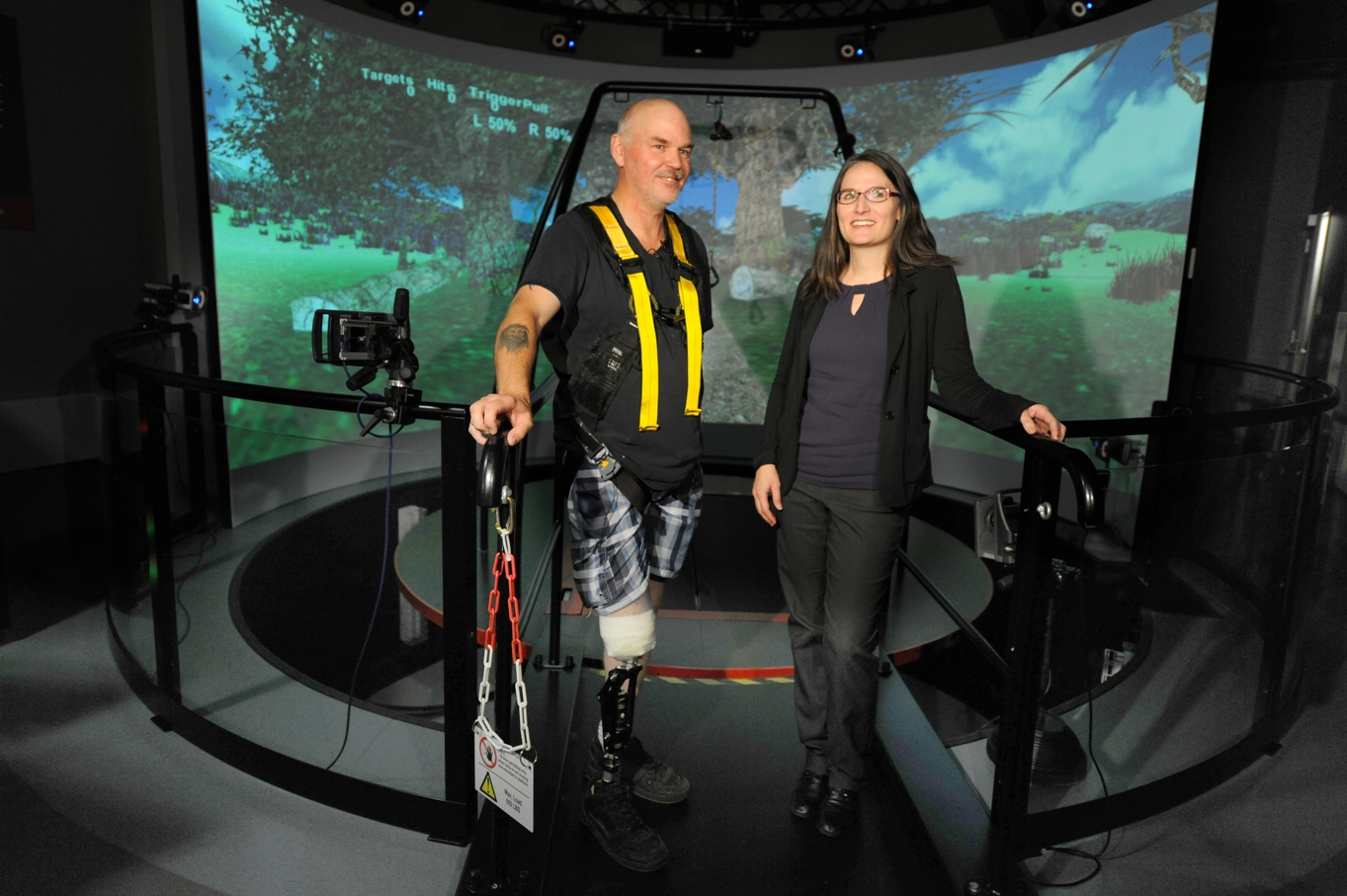
Amputees learning to walk again on a prosthetic leg are regaining the skills to do so safely and confidently thanks to virtual-reality research led by a Faculty of Medicine & Dentistry clinical scientist at the Glenrose Rehabilitation Hospital.
Through sessions on the CAREN (Computer-Assisted Rehabilitation Environment) - the only clinical virtual reality simulator of its kind in Western Canada - researchers are working to better understand the balance needs of amputees and to devise new approaches to therapy. University of Alberta researchers are working with colleagues in Ottawa on the study.
"We're looking at what a person with a single prosthesis usually does when he or she is thrown off balance," says Jacqueline Hebert, a researcher in the Faculty's Division of Physical Medicine and Rehabilitation, and Medical Lead of the Adult Amputee Program at the Glenrose. "(On the CAREN) we can actually study the biomechanics of how they're walking, what their balance reactions are, then look at that and help them train better for the real world."
As part of a national collaboration entitled "Dynamic Stability Assessment within Rehabilitation Virtual Reality Environments for Improved Mobility," Hebert's research partners include co-investigators Edward Lemaire and Emily Sinitski of The Ottawa Hospital Rehabilitation Centre, where Canada's only other clinical CAREN system is located.
As versatile as an aircraft simulator, CAREN's twin-treadmill platform, motion hydraulics and circular surround screen can be programmed by therapists to create virtually any scenario or game imaginable as it delivers a rehab program precisely tailored to each amputee's needs. As well, sensors placed on patients are tracked by overhead cameras to give objective feedback and measure progress on gait, stride, speed, weight-shift, balance and more. A patient becomes part of the simulated environment, interacts with it and changes it through their body movements.
At the Glenrose, patients walk through virtual-reality scenarios to build skill and confidence.
"For example, we can have the CAREN system in a self-pace mode, so they can walk as fast as they're comfortable walking," says Hebert. "And then they suddenly have to go up inclines, or down inclines, or over ramps - and then we can simulate a bumpy surface where it's like walking over rock, as the platform jolts them and bounces them around. That's something that we can't do in therapy on a level-surface ground. And here, it's safer than having them do it in the real world."
Terry Lewis, one patient enrolled in the study who walks 10 km a day to improve his strength and energy, says going down hills still proves a particular challenge - but the CAREN is helping.
"If it wasn't for the Glenrose and this research, I wouldn't be able to do what I'm doing now," says the 43-year-old Hinton resident, who lost his right leg earlier this year. "I think it's fabulous. You're hooked to a harness, so you're not afraid to fall. When you come out, you still have the confidence that you can do it without falling. It's helped me with my balance."
To date, 16 single-limb amputees have taken part in the national study, with more sessions and subjects expected for November. Helping amputees with lower-limb trauma also promises better rehabilitation for military veterans wounded in action, says Hebert.
Gordon Wilson, chair of the Glenrose Rehabilitation Hospital Foundation, says: "The CAREN is one of the many interventions that keep the Glenrose at the forefront of rehabilitative care and is an example of what the Glenrose Foundation makes possible. Our Foundation exists to support the outstanding work done by the hospital and its exemplary team of physicians and staff. This includes Dr. Hebert's research, which is instrumental in our continuous pursuit of care improvements that allow patients to positively shape their quality of life."
The CAREN at the Glenrose is the result of the hospital's partnership with the Department of National Defence. It can be used to rehabilitate Canadian Forces personnel and civilians with both physical and psychological injuries such as: amputations, Parkinson's Disease, stroke, brain injuries, spinal cord injuries and cerebral palsy as well as psychiatric disorders such as phobias and post-traumatic stress disorder.
Funding for CAREN came from the Government of Canada ($1.5 million) and the Government of Alberta ($250,000). Through the Courage Campaign, the Glenrose Rehabilitation Hospital Foundation also raised more than $4.5 million, which led to the 2011 opening of the Building Trades of Alberta Courage Centre and the creation of the Courage In Motion (CIM) Centre, which houses the CAREN system.